Renata Lucas
o perde
Opening – 26 APR 2024, 6-9 pm
Linienstraße 155, 10115 Berlin
In o perde, Renata Lucas’ third solo exhibition with the gallery, the artist builds upon competing notions of interaction and displacement, inviting viewers to participate in a game of billiards. The field for play is itself a sculptural object based on the traditional form of a pool table, modified by Lucas: Rather than balls being gathered once pocketed, they are instead guided away from its players – along the ground and through built barriers – triggering an off-site intervention at the nearby Neuer Berliner Kunstverein (n.b.k.) and continuing her ongoing engagement with spatial concerns.
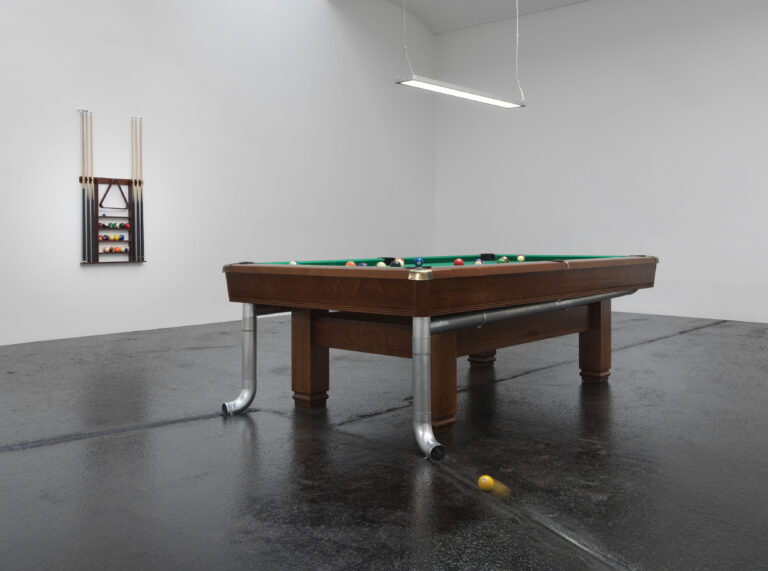
installation view: Renata Lucas, o perde, April 27 – June 7, 2024, neugerriemschneider, Berlin
© Renata Lucas. Courtesy the artist and neugerriemschneider, Berlin.
Photo: Jens Ziehe, Berlin
Lucas creates work that grapples with the psychological implications of space and its design, adopting approaches both hyperlocal and global. Always conceptualized and realized in dialogue with their contexts, her projects draw upon behaviors dictated by culture or environments. They give rise to seemingly happenstance encounters, finding site at busy intersections, on sidewalks or across cityscapes, activating and deconstructing them in pursuit of a reimagined social fabric.
The participative sculpture o perde (2024), presenting as a regulation pool table on first glance, is in fact subtly reconfigured to redirect each pocket’s ball-collection systems originally intended to capture the game’s pieces for simplified retrieval and infinite play. Lucas’ alterations interrupt this, instead allowing each ball to continue along paths that stretch away from the player, to the extents of the exhibition space and beyond, transforming a contained tabletop structure into one that is unified with its surroundings.
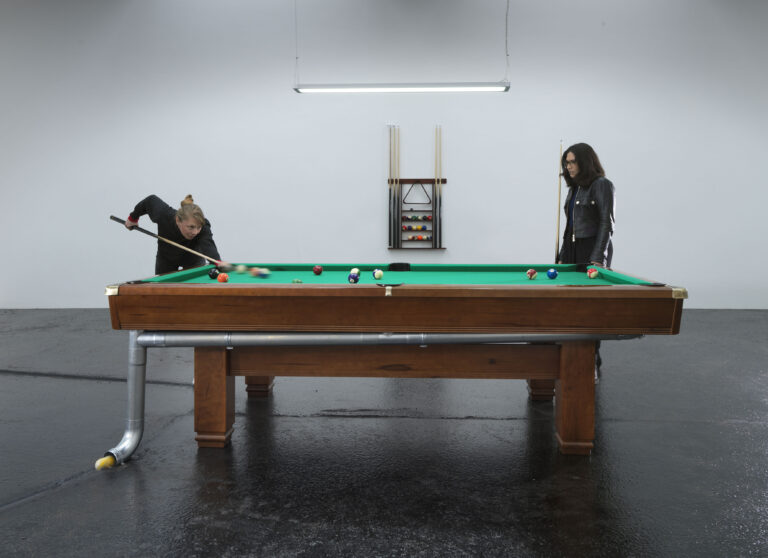
installation view: Renata Lucas, o perde, April 27 – June 7, 2024, neugerriemschneider, Berlin
© Renata Lucas. Courtesy the artist and neugerriemschneider, Berlin.
Photo: Jens Ziehe, Berlin
“Since my work interacts with, and often alters, public spaces, it requires adaptability and commitment from curators, directors and institutional teams, plus a willingness to communicate with local residents and the government departments managing public spaces.”
(Lucas, frieze 12/2021)
The work is outfitted with a series of channels that lead to the space’s floor, allowing the billiard balls to traverse architecture: Openings in the gallery’s walls allow them passage through previously impermeable barriers to the adjacent courtyard. This cyclical disappearance and reappearance elsewhere lends a surreal tone, while the illusion of control and its sudden dissolution become central. Lucas’ act introduces a rift into the otherwise ordered world of play – one governed by sets of established rules and the dynamics that they shape. She acknowledges this predetermined structure, reanimating its mechanisms of power in order to dismantle them, and constitutes a call for interpersonal exchange. o perde’s reach expands further, its sensations, sounds and physicality embedding itself within n.b.k. (Chausseestrasse 128/129, 10115 Berlin). There, the sharp, percussive tones of momentarily colliding resin accompany falling billiard balls, dispensed from the sites’ wall. Together, the exhibition’s dual sites imply a game whose location in physical and temporal spaces are indeterminate. Expectations and their defiance are deployed in tandem with the acts of displacement and superimposition, bringing the intricacies of action and causality to the fore.
“Much has been written about social critique and the relation between public and private spaces in Renata Lucas’ art. But what sets her works apart from many others that address similar issues is the fundamental absurdity of her interventions, which is rooted in her refusal to make them conform to the functionalist aspiration in urban architecture.”
(Noemi Smolik, Artforum 09/2015)
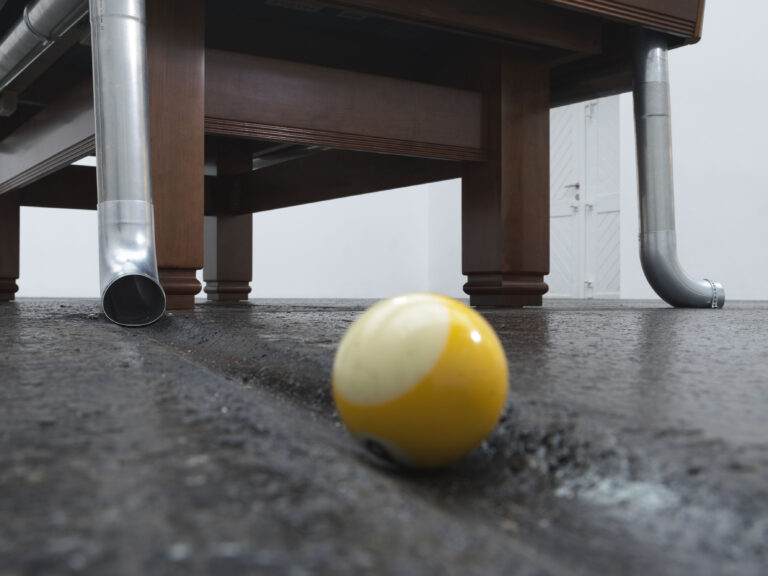
installation view: Renata Lucas, o perde, April 27 – June 7, 2024, neugerriemschneider, Berlin
© Renata Lucas. Courtesy the artist and neugerriemschneider, Berlin.
Photo: Jens Ziehe, Berlin
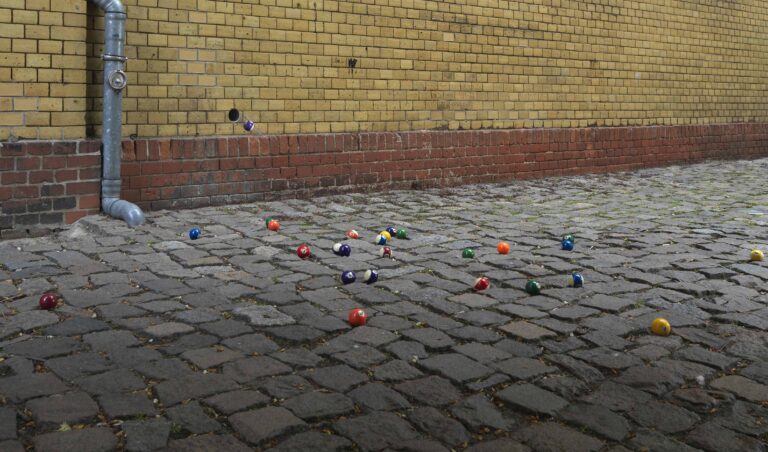
installation view: Renata Lucas, o perde, April 27 – June 7, 2024, neugerriemschneider, Berlin
© Renata Lucas. Courtesy the artist and neugerriemschneider, Berlin.
Photo: Jens Ziehe, Berlin
Renata Lucas (b. 1971) has been the subject of international solo exhibitions, including those at Performance Space New York, New York (2019); Secession, Vienna (2014); Peep-Hole, Milan (2011); KW Institute for Contemporary Art, Berlin (2010); Redcat, Los Angeles (2007); and Gasworks, London (2007). She has also created site-specific works for the 8th Biennale internationale d’art contemporain de Melle (2018); dOCUMENTA (13) (2012); the 12th Istanbul Biennial (2011); the 53rd Venice Biennale (2009); and the 27th Bienal de São Paulo (2006). Lucas lives and works in São Paulo.
This project is realized in collaboration with Neuer Berliner Kunstverein (n.b.k.).
Andreas Eriksson
of stones and lakes
Opening – 26 APR 2024, 6-9 pm
Linienstraße 155, 10115 Berlin
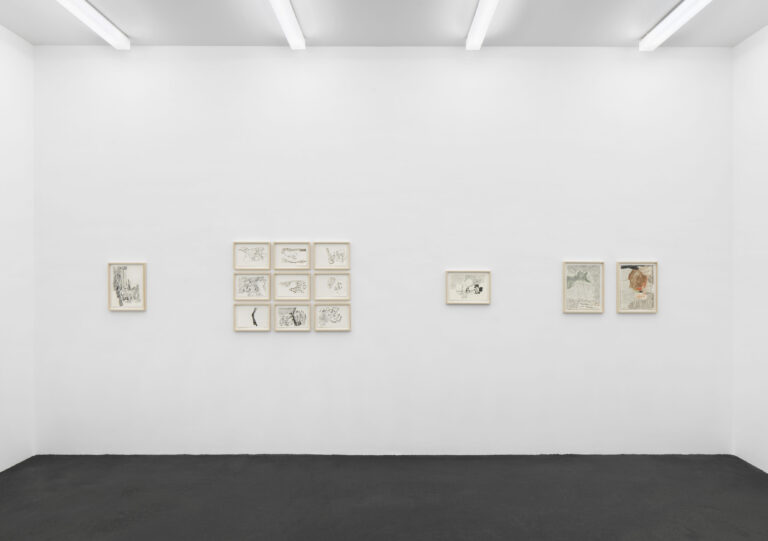
installation view: Andreas Eriksson, of stones and lakes, April 27 – June 22, neugerriemschneider, Berlin
© Andreas Eriksson.
Courtesy the artist and neugerriemschneider, Berlin.
Photo: Jens Ziehe
of stones and lakes, Andreas Eriksson’s fourth solo exhibition with the gallery, sees the artist further develop his approach to depicting environments, shifting his focus from the landscape’s vast expanse and narrowing his gaze to its minutiae. The pinpointed perspective of these works on paper, inspired by Japanese rock gardens and the natural world that envelops his studio on Sweden’s Lake Vänern, reaches past the scope of his chosen motifs and extends to the practical methods employed. Here he supplants bold, canvas-filling fields of acrylic or oil with spare, intimate applications of ink, graphite, watercolor and pastel.
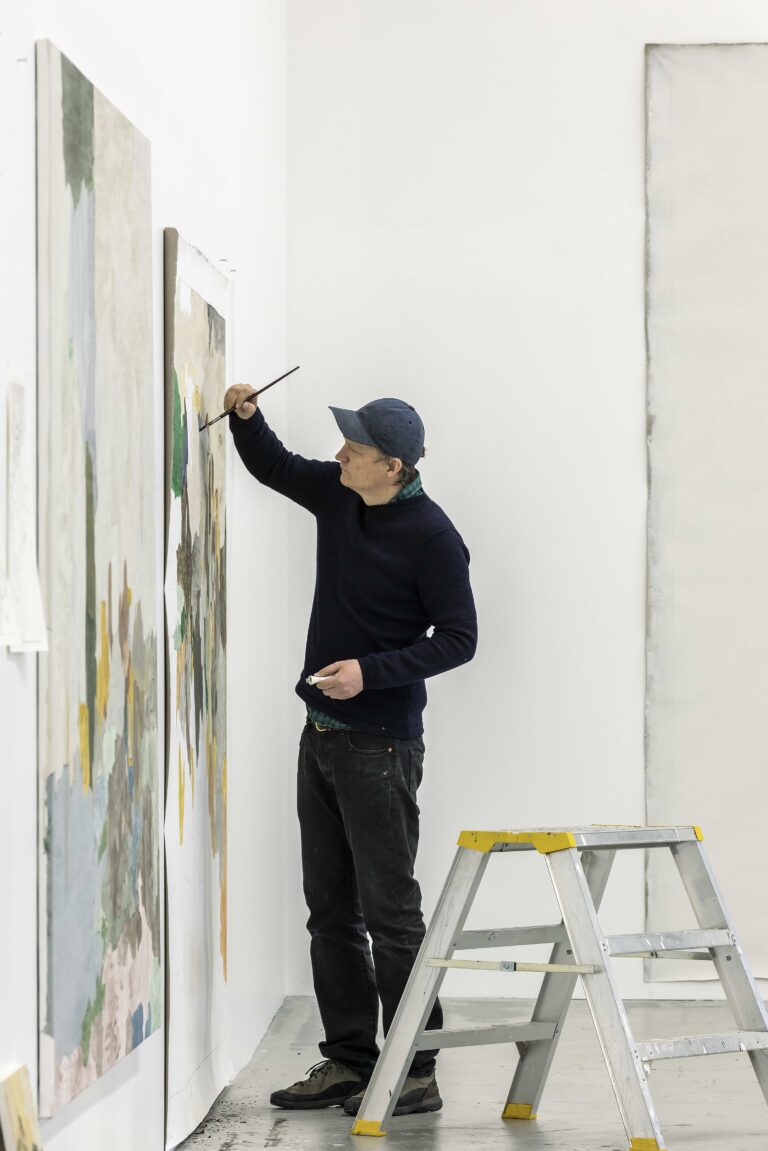
Andreas Eriksson © Andreas Eriksson.
Photo: Mathias Johansson
“The description of Andreas Eriksson’s works calls for the invention of new terms, because the available ones – landscape, nature, memory – have gone through centuries of wear and tear and are irrevocably associated with the hackneyed tropes of the European Romantic Tradition. Perhaps a successful articulation could be achieved using the same process of applying thick layers of pigment that the artist uses to compose his paintings, and adopting it to writing by combining multiple layers of words, one on the top of the other, until the resultant phonesthemes speak for themselves.”
(Filipa Ramos, Frieze 04/2014)
Eriksson’s body of paintings, weavings, drawings, prints and sculptures stands both as a tribute to organic phenomena and an exploration of their infinite intricacies. Each canvas, tapestry or sheet is a transmission of the indelible impressions left by his source – their subjects reverential records of life itself, and of the forces that lend it shape. His delicate layers of media come to parallel the structure of existence, and reflect an understanding of it born from dedicated observation. Dichotomies and dualities become central to his engagement, with the abstract and the figurative, the weighted and the weightless, the internal and the external, the vivid and the obscure, or the illusive and the real occupying equal space in his tact and its manifestations.
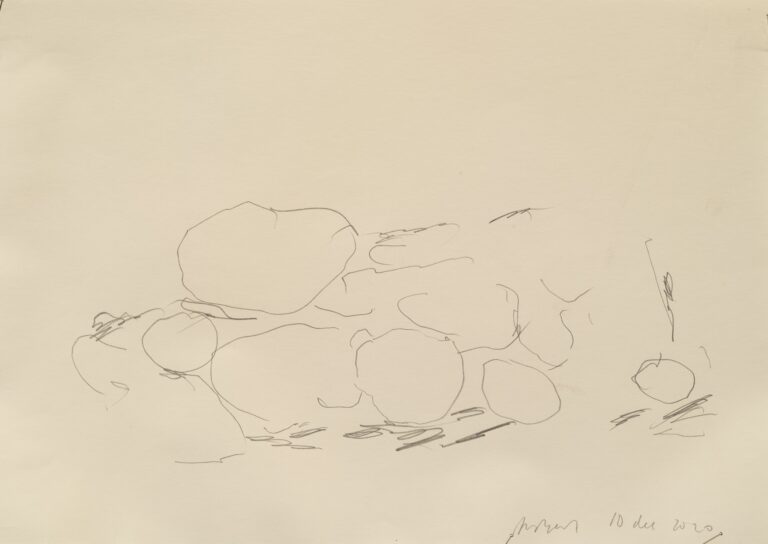
Andreas Eriksson Untitled, 2020
© Andreas Eriksson. Courtesy the artist and neugerriemschneider, Berlin
graphite on paper
22.5 x 31.8 cm
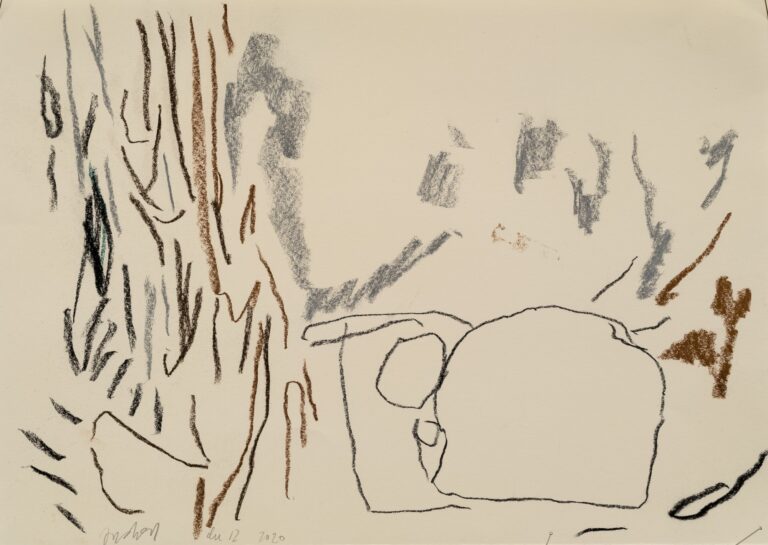
Andreas Eriksson, Untitled, 2020
© Andreas Eriksson. Courtesy the artist and neugerriemschneider, Berlin
The works that comprise of stones and lakes grow from Eriksson’s keen sense of attunement, honed in an artistic practice that derives its strength from subtle shifts. Considered use of material becomes meditative, with intuitive markmaking standing at the union of gestures calculated and extemporaneous. His images – their linked streaks, staccato dashes or fluid linework – link his own physical setting with rock gardens’ to-scale approximations of nature’s core. The gardens’ distilled, self-contained representations of the world beyond, influenced by the clarity of early landscape painting, find analog in Eriksson’s own approach, itself characterized by sensitive regard for his surroundings and their interpretation. Compositions in compressed perspective deconstruct and reconstitute this mode, picturing stones standing solitarily or in dialogue: the mountains, ridges or pathways of dry gardens in their elemental states. Eriksson’s organic contours possess an instinctual balance, with each image paying homage to the eternal fortitude of their protagonists. Delineating his subjects decisively, Eriksson creates windows that frame not only their form, but their essence, harnessing the ever-transforming phenomena that define them.
“What’s remarkable about Andreas Eriksson’s paintings is that even as they manage to impart this quite particular, somehow cold, hard sense of separation, the crumbling crusts of their surfaces make them seem alive.”
(Kristian Vistrup Madsen, Artforum 05/2020)
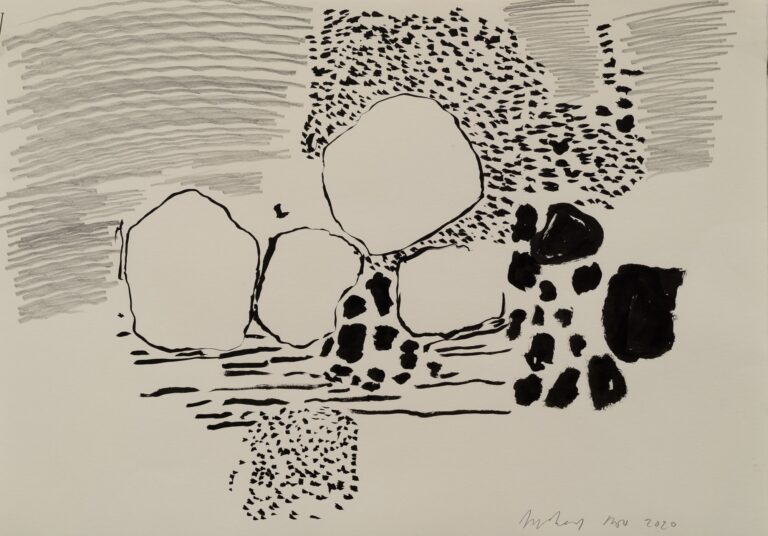
Andreas Eriksson, Untitled, 2020
© Andreas Eriksson. Courtesy the artist and neugerriemschneider, Berlin
ink and graphite on paper
22.5 x 32 cm
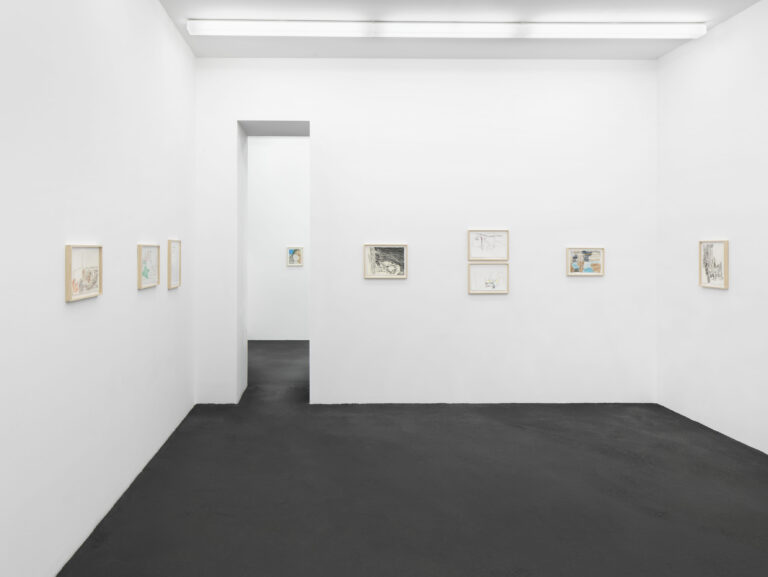
installation view: Andreas Eriksson, of stones and lakes, April 27 – June 22, neugerriemschneider, Berlin
© Andreas Eriksson.
Courtesy the artist and neugerriemschneider, Berlin.
Photo: Jens Ziehe
Andreas Eriksson (b. 1975) has been the subject of international solo exhibitions, including those at Lillehammer Art Museum, Lillehammer (2024); Thielska galleriet, Stockholm (2023); Skissernas Museum, Lund (2021); Nordiska Akvarellmuseet, Skärhamn (2020); Cahiers d’Art, Paris (2020); Braunsfelder, Cologne (2019); Kunstforum Baloise, Basel (2015); Bonniers Konsthall, Stockholm (2014); Trondheim kunstmuseum, Trondheim (2014); Centre PasquArt, Biel (2014); Reykjavík Art Museum, Reykjavík (2014); and mumok – Museum moderner Kunst Stiftung Ludwig Wien, Vienna (2008). Eriksson was selected to participate in the third Jeju Biennale in 2022, the 30th Bienal de São Paulo in 2012 and the 54th Venice Biennale’s Nordic Pavilion in 2011 representing Sweden. Eriksson lives and works in Medelplana, Sweden.
Rirkrit Tiravanija
untitled 2024 (the sea you see is not what others see the sea you see is not what other see)
Opening – 26 APR 2024, 6-9 pm
Christinenstraße 18 – 19, 10119 Berlin
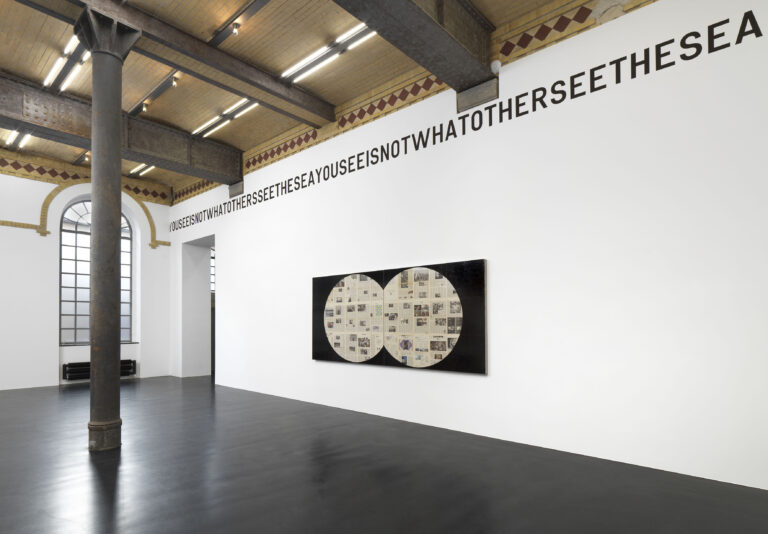
installation view: Rirkrit Tiravanija, untitled 2024 (the sea you see is not what others see the sea you see is not what other see), April 27 – August 17, 2024, neugerriemschneider, Berlin
© Rirkrit Tiravanija. Courtesy the artist and neugerriemschneider, Berlin.
Photo: Jens Ziehe, Berlin
Rirkrit Tiravanija’s untitled 2024 (the sea you see is not what others see the sea you see is not what other see), his tenth solo exhibition with the gallery, presents a series of paintings that explore the power of symbols in the collective consciousness, mining narratives historical and contemporary in pursuit of a language of imagery that furthers his extended artistic engagement with bold aphorisms, allegories and political statements. Weaving thematics of recognition, with dynamics of transmission and pivotal references from his own practice, these works appropriate centuries-old pirate flags and images of the sea, emblazoning them across newspaper-lined canvases.
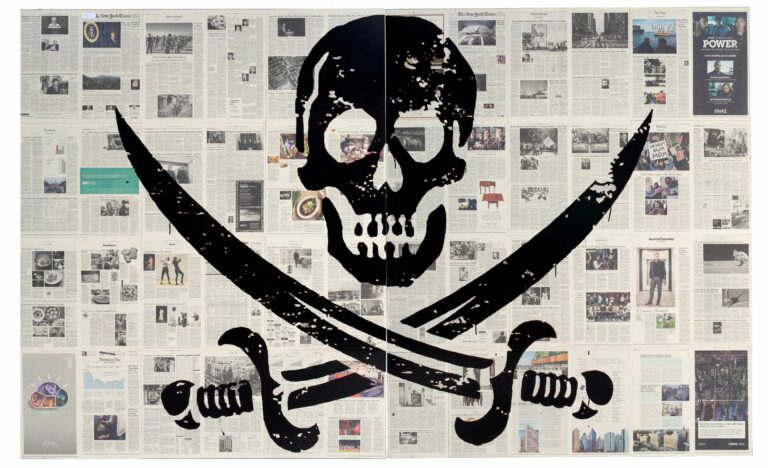
Rirkrit Tiravanija, untitled 2020 (black flag no. 1, new york times, january 17/18, 2018), 2020
© Rirkrit Tiravanija. Courtesy the artist and neugerriemschneider, Berlin
tree lacquer on newspaper on canvas
2 parts: 222 x 182 cm each
Symbols, for Tiravanija, derive strength from their capacity to communicate concepts and messages across boundaries cultural, linguistic and temporal, and gain intrigue as their connotations, over time, are distanced from their sources. This process – the susceptibility of images to undergo transformation, co-option or stasis as a factor of widened circulation – has become crucial for the artist, who throughout his body of work considers how de- and recontextualization of ideas casts them in entirely new lights or, under certain conditions, preserves them. Here, Tiravanija centers his focus on a selection of pirate flags flown throughout the 18th century, each of which employ the now-universally recognizable skull-and-crossbones pictogram initially used as a tool of identification and intimidation. Since, the pairing has come to evoke a diverse cross-section of at-odds connotations, at once a marker of danger, kept intact from its inception, and one that conjures the romantic separatism of historic piracy as proliferated through media. Seemingly resting on their corners, the large-scale works emulate flags draped from masts, their tilt implying movement while their rigidity situates them firmly within a painterly context.
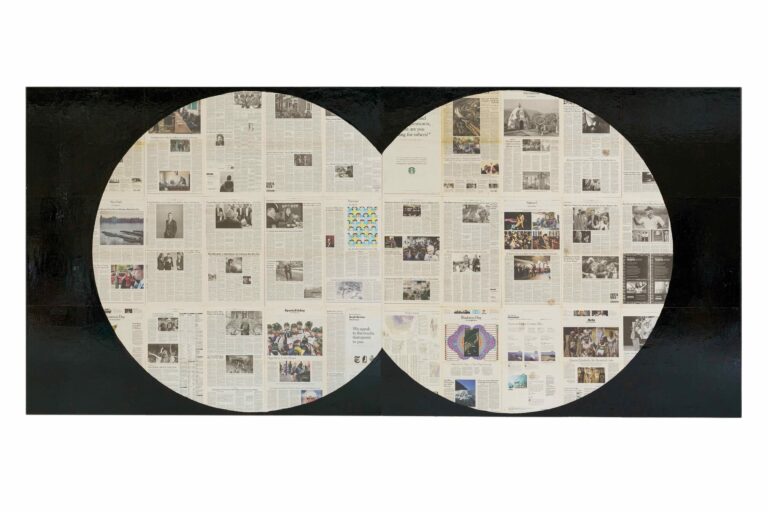
Rirkrit Tiravanija, untitled 2024 (a view of distant objects, new york times, january 12/15, 2018), 2024
© Rirkrit Tiravanija. Courtesy the artist and neugerriemschneider, Berlin
tree lacquer on newspaper on canvas
2 parts: 168 x 183 cm each
“When I look at certain gatherings organised by Tiravanija, they in a sense provide access to the horrifically lacking basic dignities of living: eating well, resting well, being well together and learning. Despite his cool self-representation with regard to the impacts of his gatherings, Tiravanija simmers in his focused curiosity for human habits, and our conflictual desire to be together but also exploit one another. His artworks are equally sites for inquiry, joy and practising trust.”
(Laney, ArtReview 10/2023)
Accompanying these works are further canvases embodying the sea’s uncertain expanse and all that it connotes – a two-part composition picturing the circular silhouetting of binoculars, and a suite of 27 portrayals of graphically rendered waves. In coating each of the exhibition’s canvases with issues of the New York Times, and in turn using these as sites for applications of thick, tar-like lacquer, Tiravanija continues his practice of deploying newspapers as a pictorial ground. The veritable flood of information that the spreads present stands in decided opposition to the artist’s pared-down, highly legible motifs, giving rise to the union of disparate modes of exchange, while the fusion of temporal contexts speaks directly to the cyclical nature of chronology – a circuit within which narratives cross, overlap, grow from one another and diverge at will.
Arrrrrrrrrrrrrrrrrrrrrrrrrrrrrrrrrrrrrrrrrrrrrrrrrrrrrrrrrrrrrrrrrrrrrrrrrrrrrrrrrrrrrrrrrrrrrrrrrrrrrrrrrrrrrrrrrrrrrrrrrrrrrrrrrrrrrrrrrrrr
rrrrrrrrrrrrrrrrrrrrrrrrrrrrrrrrrrrrrrrrrrrrrrrrrrrrrrrrrrrrrrrrrrrrrrrrrrrrrrrrrrrrrrrrrrrrrrrrrrrrrrrrrrrrrrrrrrrrrrrrrrrrrrrrrrrrrrrrrrrrr
rrrrrrrrrrrrrrrrrrrrrrrrrrrrrrrrrrrrr
“A LOT OF PEOPLE is relevant to our contemporary context yet evades the trap of institutional trendiness. It avoids mere allusions to urgent inquiries in curatorial and museological practice today. It also manages to break the fourth wall between the public and the institution in a way that is rarely actualized in museum contexts. The exhibition provides a refreshing space of expliration and play that reminds visitors that art, especially art on view in museums, does not have to be neat tidy, and conventionally delineated…”
(Mannarino, Flash Art 12/2023)
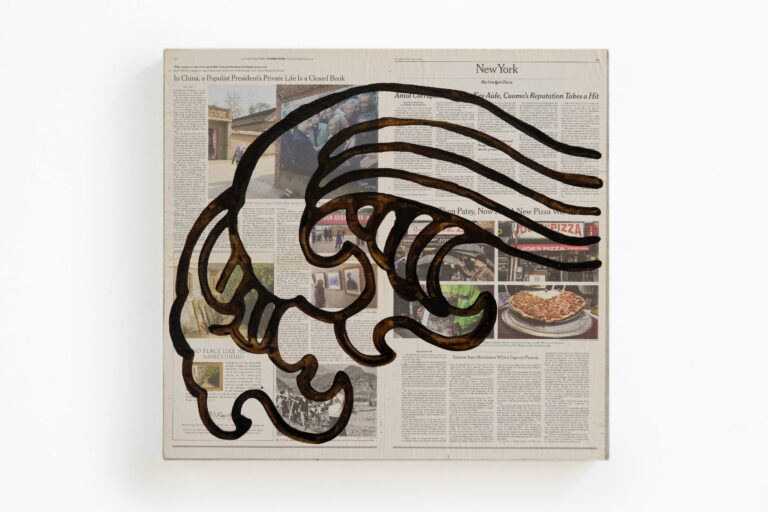
Rirkrit Tiravanija untitled 2024 (the sea you see is not what others see, new york times, march 6, 2018) (no. 2), 2024
© Rirkrit Tiravanija. Courtesy the artist and neugerriemschneider, Berlin
tree lacquer and newspaper on canvas
56 x 61 cm
Rirkrit Tiravanija (b. 1961) is the focus of the upcoming survey DAS GLÜCK IST NICHT IMMER LUSTIG (HAPPINESS IS NOT ALWAYS FUN) at Gropius Bau, Berlin this September. He has been the subject of international solo exhibitions at MoMA PS1, New York (2023); Hirshhorn Museum and Sculpture Garden, Washington, D.C. (2019); Stedelijk Museum Amsterdam, Amsterdam (2016); Garage Museum of Contemporary Art, Moscow (2015); Kunsthalle Bielefeld, Bielefeld (2010); Kunsthalle Fridericianum, Kassel (2009); Musée d’Art Moderne de la Ville de Paris, Paris (2005); Solomon R. Guggenheim Museum, New York (2005); Serpentine Gallery, London (2005); and Museum Boijmans Van Beuningen, Rotterdam (2004), among others. His work has been included in biennials and triennials including La Biennale di Venezia (2015, 2003, 1999, 1993); Sharjah Biennial (2015, 2007); Gwangju Biennale (2012); Yokohama Triennale (2008, 2001); Biennale d’art contemporain de Lyon (2007, 2005, 1995); Bienal de São Paulo (2006); Istanbul Biennial (2001); Biennale of Sydney (1998); Berlin Biennale for Contemporary Art (1998); and Manifesta, Rotterdam (1996). Tiravanija lives and works in Chiang Mai, Berlin and New York.
Cory Arcangel
Let’s Play Majerus G3
Opening – 25 APR 2024, 6-8 pm
Long Opening hours – 26 APR 2024, 6-9 pm
Michel Majerus Estate, Knaackstraße 12, 10405 Berlin
The Michel Majerus Estate is pleased to announce Let’s Play Majerus G3, a project featuring a previously unexplored aspect of the artist’s archive: his computer. An initiative led by artist Cory Arcangel, Let’s Play Majerus G3 takes as its point of departure the laptop that Majerus used in his late career, now reactivated following a restoration undertaken in cooperation with digital-art organization Rhizome.
By examining this crucial tool, Let’s Play Majerus G3 — an expansive program comprising the exhibition at the Michel Majerus Estate, a talk, a performance and a YouTube series — allows unprecedented access to Majerus’ digital studio and the approaches that informed it, representing a revolutionary development in the understanding of his oeuvre, and allowing a uniquely first-hand glimpse, through the eyes of a fellow artist, into this rich primary source.
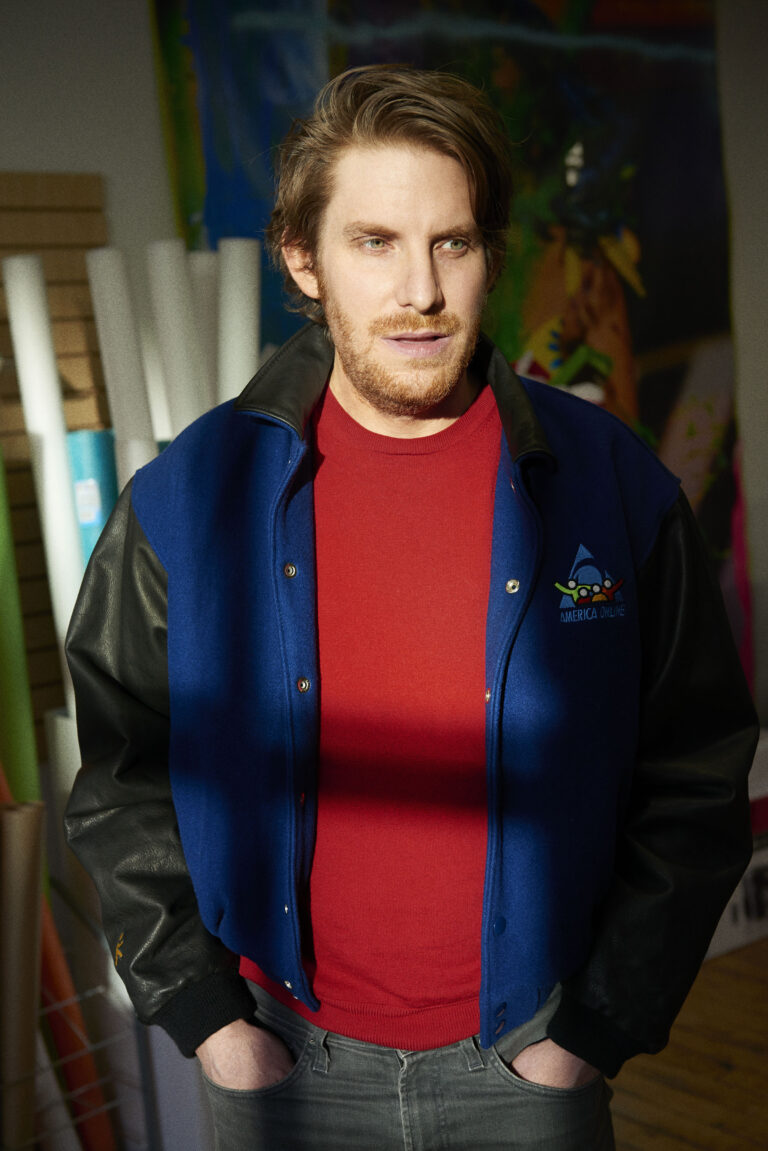
Cory Arcangel
Foto/ Photo: Tim Barber
As culture itself becomes increasingly digitized, more and more of it will end up in drawers like this — discarded, forgotten, and inoperable.
– Cory Arcangel in Artforum, summer 2014
While their respective practices began nearly a decade apart, and despite the disparate nature of their media, Majerus and Arcangel are united by a core interest in the aesthetics of digital imagery, the generative potential of new technologies, critique of said technologies and the free traversal of analog and digital worlds.
In 2022, Kunstverein in Hamburg staged Data Streaming, an exhibition that showcased a selection of late work by Majerus, and probed how the increasing presence of the digital in the late 1990s profoundly impacted his practice. On view concurrently with Arcangel’s presentation Flying Foxes, the pairing of shows brought the dialogue between the two artists to the fore, drawing attention to the brief moment in which their practices overlapped.
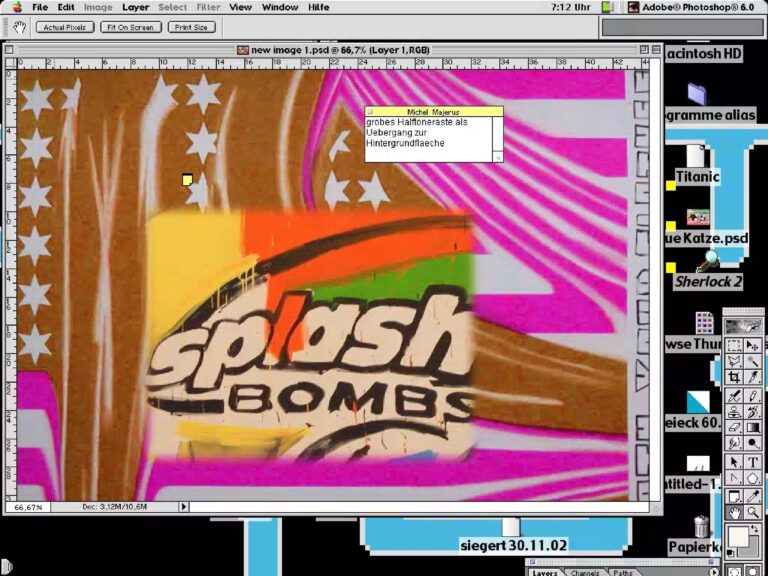
Bildschirmfoto einer Photoshop datei / Screenshot of photoshop file on Michel Majerus’ laptop (Powerbook G3)
Aufgenommen von / selected by Cory Arcangel, Nov. 2024
© Michel Majerus Estate, 2024
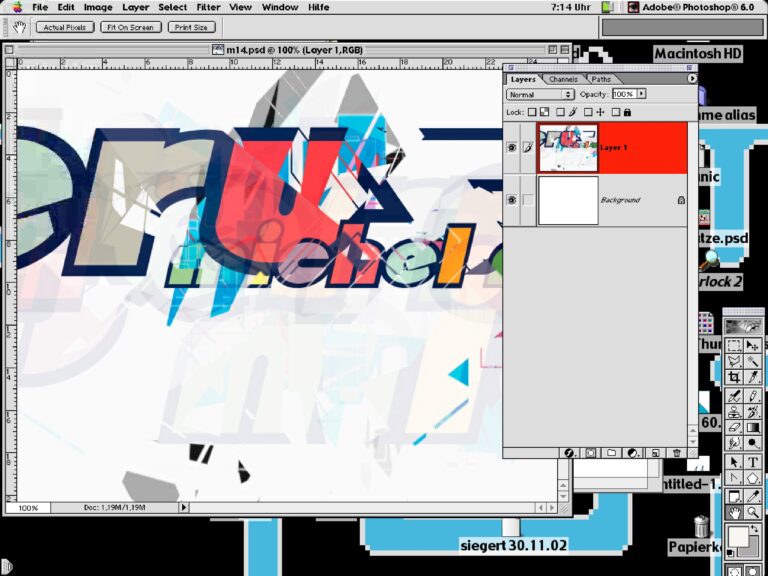
Bildschirmfoto einer Photoshop datei / Screenshot of photoshop file on Michel Majerus’ laptop (Powerbook G3)
Aufgenommen von / selected by Cory Arcangel, Nov. 2024
© Michel Majerus Estate, 2024
Using emulation developed by Dragan Espenschied and Mona Ulrich from Rhizome, Arcangel here reactivates Majerus’ laptop (a 1998 Macintosh PowerBook G3) — a tool that Majerus spent significant time with on a daily basis, conceiving works and exhibitions, assembling his schedule, conducting communication and experimenting with software. Arcangel’s project highlights Majerus’ use of the then-burgeoning internet, the scale, speed, accessibility and autonomy of which opened new doors for artists, and affords a singularly comprehensive look at his digital studio. Within the emulation environment, Majerus’ computer exists as the artist last used it, exactly as it stood in 2002, providing detailed insight into his process of conception, production and display, with files ranging from sketches of future works to exhibition views of them in their realized forms.
Arcangel’s work is driven by the temporality and technological dependence of aesthetics, with modern-day technology constituting, in a broad sense, a key advancement in human history — a chronology that includes everything from musical instruments of the Renaissance to contemporary video games. Among a generation of artists distinguished by the integration of new media in their practices, Arcangel’s early negotiation of a digital present stands as exceptional.
His engagement with archival computing here builds upon a 2014 project in which he, together with several organizations including the Carnegie Mellon Computer Club — a team specializing in obsolete computers — accessed over 30-year-old floppy discs from the collection of the Andy Warhol Museum in Pittsburgh, rescuing a group of long-lost digital works by the artist.
The project at the Michel Majerus Estate, in exploring and presenting Majerus’ computer, foregrounds the technological challenge of re-accessing a wealth of information thought to be lost. It lends consideration to the increasingly prominent role of archiving digital materials and interrogates the ways in which these holdings crucially factor into authoring arthistorical narratives surrounding 21st-century protagonists.
Let’s Play Majerus G3 is accompanied by an in-person and online program. The exhibition at the Michel Majerus Estate features works by Arcangel that span nearly two decades, including new commissions displayed alongside selected works by Majerus in a juxtaposition that suggests a continuity in non-concurrent, albeit conceptually linked, bodies of work.
On YouTube, Arcangel — in his debut as a “YouTuber” — posts “Let’s Play” videos that feature him as he navigates Majerus’ computer as part of this project. These videos are also presented on the Michel Majerus Estate’s website and by Rhizome as part of their series of presentations on digital-art archival, “ArtBase Anthologies.”
The project is accompanied by a conversation between Cory Arcangel and Dragan Espenschied during Gallery Weekend Berlin, followed by a new iteration of Arcangel’s performance The AUDMCRS Underground Dance Music Collection of Recorded Sound (2015 – ongoing) in fall 2024, and a series of events with Rhizome conducted over the course of the exhibition.
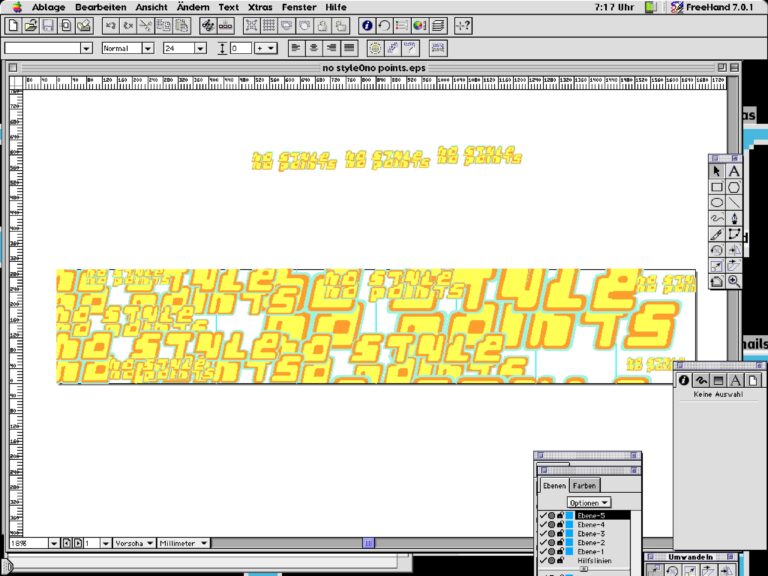
Bildschirmfoto einer Photoshop datei / Screenshot of photoshop file on Michel Majerus’ laptop (Powerbook G3)
Aufgenommen von / selected by Cory Arcangel, Nov. 2023
© Michel Majerus Estate, 2024
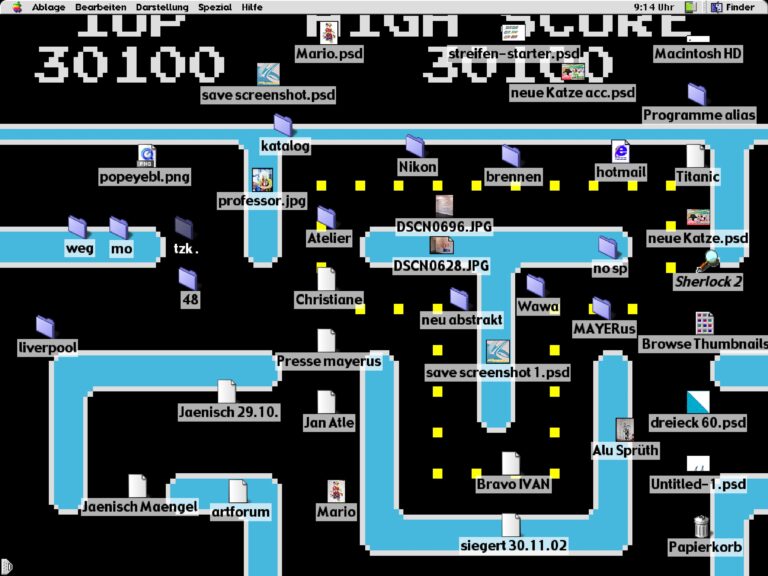
Bildschirmfoto des Desktops von / Screenshot of photoshop file on Michel Majerus’ laptop (Powerbook G3)
Aufgenommen von / selected by Cory Arcangel, Nov. 2023
© Michel Majerus Estate, 2024
Let’s Play: Majerus G3 was created in cooperation with Rhizome, an artist-founded platform for presenting, researching, and preserving digital art. The emulation of Majerus’ computer, developed by OpenSLX, was overseen by Dragan Espenschied (Preservation Director at Rhizome) and Mona Ulrich. The project is supported by grants from the Institute for Contemporary Art Research (IFCAR), awarded by the Zurich University of the Arts, where Arcangel currently teaches; and from Arcangel Surfware, a software and merchandise publisher founded by Arcangel in 2014.
Cory Arcangel (b. 1978, Buffalo, US) is an artist living and working in Stavanger, Norway. His work has been the subject of solo exhibitions at Kunstverein in Hamburg, Hamburg (2022); Whitney Museum of American Art, New York (2011); Carnegie Museum of Art, Pittsburgh (2012); The Barbican, London (2011); Reykjavik Art Museum, Iceland (2015); Hamburger Bahnhof — Museum für Gegenwart, Berlin (2010); Museum of Contemporary Art, North Miami (2010) and Migros Museum für Gegenwartskunst, Zurich (2005).
Rhizome champions born-digital art and culture through commissions, exhibitions, scholarship and digital art conservation. Founded in 1996 by artist Mark Tribe as an email discussion list including some of the first artists to work online, Rhizome has played an integral role in the history of contemporary art engaged with digital technologies and the internet. Since 2003, Rhizome has been an affiliate in residence at the New Museum in New York City.
Housed in the artist’s former studio, the Michel Majerus Estate is dedicated to researching, presenting and contextualizing the work of Michel Majerus (1967 – 2002), and preserving the cultural legacy of an extensive oeuvre created during a short period that began in the late 1980s. In this time, he developed a pioneering visual language that freely drew upon subcultures, mass media, nascent digital technologies and a wide array of arthistorical sources, sampling their component parts and reintegrating them into his compositions and installations. Since 2012, the Michel Majerus Estate has invited guest curators, scholars and artists to engage with Majerus’ practice through exhibitions and projects staged at the Estate. Previous collaborators include Brigitte Franzen, Fabian Schöneich, Joseph Kosuth, Laura Owens and Jordan Wolfson.
